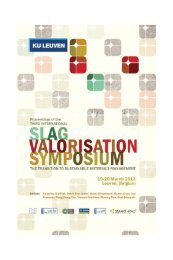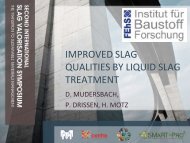International Slag Valorisation SymposiumLeuven6-7/4/2009 - Third ...
International Slag Valorisation SymposiumLeuven6-7/4/2009 - Third ...
International Slag Valorisation SymposiumLeuven6-7/4/2009 - Third ...
Create successful ePaper yourself
Turn your PDF publications into a flip-book with our unique Google optimized e-Paper software.
volume (kg/t of hot rolled coil) and concentration of CO2 (volume %). The major CO2<br />
stream comes out of the blast furnace and accounts for 69% of all Steel Mill emissions<br />
to the atmosphere. This is indeed where most of the reduction takes place and where<br />
most of the energy is needed. The top gas of the blast furnace is composed of roughly<br />
25% of CO 2, the rest being CO at a similar concentration with a complement of<br />
nitrogen. The other stacks all together account for 31% of the emissions: they exhibit<br />
rather low CO2 concentrations, typical of the flue gas in a conventional boiler,<br />
combustion chamber or power station. Of course, the BF top gas never ends up directly<br />
in a stack, as the embedded energy is recovered in a power plant, which is part of the<br />
Mill complex. A Direct Reduction steel mill generates CO2 in lesser quantities at the<br />
stack of the DR plant - as well as downstream at the steel shop and rolling mills, like in<br />
the ISM. An EAF mill generates even smaller amounts of CO 2, from the steelshop on:<br />
most of its emissions are actually due to electricity production needed to power the<br />
EAF.<br />
Strategies to control CO2 emissions from the Steel Sector<br />
A state of the art Steel Mill is a very optimised system in terms of consumption of fuels<br />
and reducing agents. The Blast Furnace itself operates 5% away from thermodynamic<br />
limits and the whole mill has a potential of energy savings of roughly 10% only. This is<br />
due to several decades of cost management, as high energy prices have driven the<br />
industry to optimise its processes as close as possible to physical limits. The Industry<br />
rightfully claims energy savings and, correspondingly, CO2 cuts which range between<br />
50 and 60% over the last 40 years, depending on the local conditions: this is the highest<br />
level of energy conservation achieved by any industrial sector. Cutting CO2 emissions<br />
further, to the level that post-Kyoto policies require, raises therefore specific challenges:<br />
it is indeed necessary to uncouple energy savings and CO 2 reduction in the Steel sector<br />
– an original feature compared to other sectors.<br />
First, a more or less obvious fact that ought to be stated anyway, is that the usage of<br />
steel scrap should be kept at the high level that it has reached today. It is estimated that<br />
the collecting rate of obsolete scrap is around 85% today, which forms the basis of a<br />
strong recycling economy, complete with scrap dealerships and a specific steel<br />
production route based on the EAF. In simple words, value is created by the recycling<br />
of virtually all available scrap. In the long term, this situation will continue. It should<br />
also be pointed out that the indirect emissions related to electricity production will<br />
evolve with time. For example, ULCOS has shown that, under a strong carbon<br />
constraint, the carbon intensity of the European electricity grid will drop from 370<br />
gCO2/kWh in 2006, to 144 g in 2050, a specific drop of 55% which will be translated at<br />
the same level in indirect emissions. 3)<br />
1 st <strong>International</strong> <strong>Slag</strong> <strong>Valorisation</strong> Symposium│Leuven│6-7/4/<strong>2009</strong><br />
18







